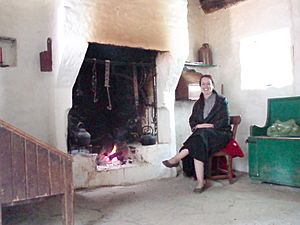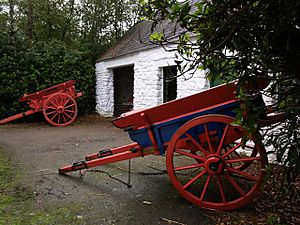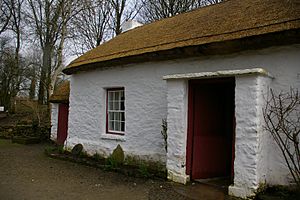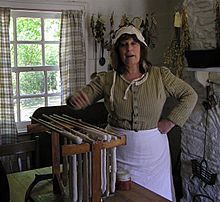Ulster American Folk Park facts for kids
| Daonpháirc Uladh-Mheiriceá (Irish) Ulstèr Merikay Fowk Pairk (Ulster-Scots) |
|
 |
|
| Lua error in Module:Location_map at line 420: attempt to index field 'wikibase' (a nil value). | |
| Established | 1976 |
|---|---|
| Location | Castletown, Northern Ireland |
| Visitors | 112,916 (2019) |
The Ulster American Folk Park is an exciting open-air museum located near Omagh, in County Tyrone, Northern Ireland. It's a place where you can explore more than 30 different buildings. The museum shares the amazing story of Irish people moving to other countries over three centuries.
At the park, friendly guides dressed in old-fashioned clothes show you around. You can also see displays of traditional crafts. The museum mainly focuses on people who left Ulster for America during the 1700s, 1800s, and 1900s. This museum is part of the National Museums Northern Ireland group.
Many of the buildings at the museum are real, old homes that have been carefully moved and rebuilt. They often have links to local families. The park was built around the Mellon House. This was the birthplace of Thomas Mellon, a famous Irish-American banker and lawyer. He started the important Mellon banking family. His house and its smaller buildings are still in their original spot.
Visitors can even try tasty samples of old Irish and American pioneer foods. Imagine fresh soda bread or pumpkin pie, all cooked on old hearths and griddles! The museum also shows off old farming tools and has many farm animals. The park is open most of the year, except for some public holidays.
Contents
Discovering History: Themes at the Park
The Ulster American Folk Park brings history to life with many demonstrations. You can see how people used to do daily tasks and learn old skills. This includes things like blacksmithing (working with metal), making candles, embroidery (fancy sewing), spinning thread, using a printing press, and cooking over an open fire.
The museum always has fun events and exhibitions that connect to its collections. In recent years, it has hosted big international shows. One was Fighting Irishmen, which showed how Irish people influenced boxing. Another was Warriors of the Plains from the British Museum. This exhibition explored the lives of Native American people.
The park also celebrates special days from both the New World (America) and the Old World (Ireland). These include U.S. Independence Day, Halloween, Easter, and of course, Saint Patrick's Day. If you love music, there's a three-day Bluegrass Music Festival every September. It celebrates the mix of music brought by emigrants.
The museum's visitor centre has a cafe and a shop. It also has a permanent exhibition called Emigrants. This show introduces you to the story of people leaving Ireland for America. After seeing it, you can start your journey around the outdoor museum and follow the emigrant trail. There's free parking available right at the museum.

Exploring the Park: Different Sections
Learning and Research
The entrance area of the museum has a restaurant and a visitor information centre. It also houses the Centre for Migration Studies (CMS). This centre has a library and works with the University of Ulster and Queen's University of Belfast. They offer courses for university students and shorter classes. All these courses focus on studying Irish migration from the 1600s to today.
The special research library has about 10,000 books and many magazines. It also has maps, videos, and a collection of original documents. These documents are part of the Irish Emigration Database, which you can search on a computer. The centre is open to visitors during regular office hours but closes on public holidays.
The Old World: Life in Ireland


The Old World part of the park shows you what life was like in Ireland. It has whole streets of original houses, an old printing press, a bank, and an old police station. There's also the old Castletown National School and two churches. A very important building here is the childhood home of Thomas Mellon. He was the judge who started the famous Mellon banking family in Pittsburgh.
Some of the small, two-story houses in one of the rebuilt streets were actually moved piece by piece from Sandy Row in Belfast. Other buildings were brought from different parts of the province.
The New World: Life in America
To get from the Old World to the New World sections, you go through the Ship and Dockside gallery. Here, you'll see the Brig Union. This is a full-size copy of a sailing ship that immigrants would have traveled on.
The feeling of history continues in the New World area. It has a recreated old American street with a tinsmith's shop and the original inside of a general store from Virginia. Beyond the street, your journey into the frontier begins. You can stop at the 1720s Fulton stone house. This house was carefully taken apart in Lancaster County, Pennsylvania, and rebuilt here.
Other original frontier houses in the park include an Appalachian log house from Washington County, Pennsylvania. There's also the 1830 home of Richard McCallister from Cabell County, West Virginia. Finally, you can see a brick plantation house built by Francis Rogan in the early 1800s near Nashville, Tennessee.
More to Explore

